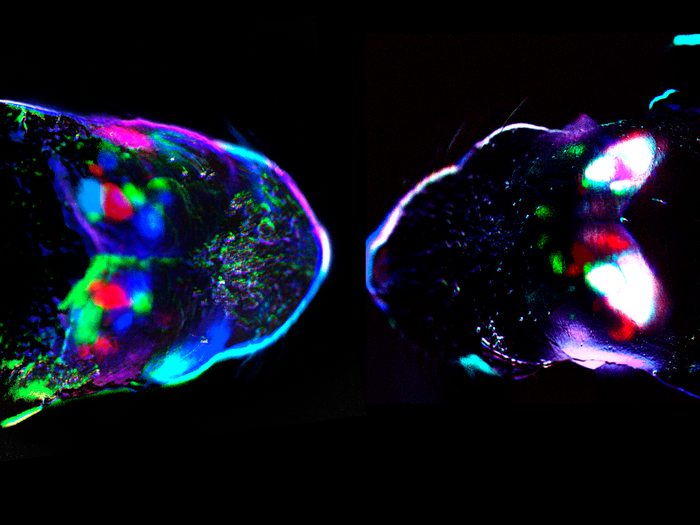Article
Study: Touch and sight are linked before birth
Author(s):
In embryonic stages, tactile stimuli simultaneously activate tactile and visual neural pathways. Shortly after birth, both pathways reorganize to allow separate processing of touch and vision. The change of pathway is facilitated by the activity waves of the retina, which act as railroads that direct the stimuli of each sensory modality to the corresponding cortex, so that we can perceive them separately.
Cortical spontaneous activity at birth in a control mouse (left) and a mouse where retinal waves were blocked by carbenoxolone injection into the eye (right). (Image courtesy of Instituto de Neurociencias)

In embryonic stages, tactile stimuli simultaneously activate tactile and visual neural pathways. Shortly after birth, both pathways reorganize to allow separate processing of touch and vision. Waves of activity emitted by the retina around birth drives the separation of touch and sight, according to a study by the UMH-CSIC Neurosciences Institute published in Science.1
This separation occurs in a brain structure called the superior colliculus that acts as a distributor of neural circuits or pathways. Any delay in the development of this separation causes an incorrect organization of visual circuits that is maintained in adult life.
According to a news release from the UMH-CSIC Neurosciences Institute, a study from the laboratory of Guillermina López-Bendito, PhD, shows in mice that the circuits of touch and sight are not independent in the embryo, but are intermingled. It is at birth when these circuits separate and responses to sensory stimuli become independent.
In a previous study, López-Bendito's lab showed that tactile stimuli activate brain circuits designed to process this type of information before birth.
“But we wanted to determine whether they do so independently or whether there is a temporary overlap with other senses,” López-Bendito said in the release. “This new study provides fascinating data on how the senses are segregated in the first days of life.”
In this work, led by Teresa Guillamón-Vivancos, PhD, investigators have shown, for the first time, in vivo in mice that during embryonic development a tactile stimulus not only triggers the expected response in the primary somatosensory cortex (one of the areas of the brain that deals with the sense of touch), but surprisingly also gives rise to a response in the primary visual cortex of both hemispheres.
Guillamón-Vivancos noted in the news release that this multimodal (i.e., encompassing more than one sense) response was observed in mouse embryos tested on the last day of gestation, but disappeared with birth.
“We then tested whether the disappearance of this multimodal response could be related to the arrival of signals from the retina to the cerebral cortex and other brain structures,” she said in the release. “Our data show that somatosensory and visual circuits are not secreted by default, but require the arrival of activity waves from the retina to do so.”
PATHWAY SEPARATION
According to the news release, this fundamental process of separation of sensory circuits occurs during a window of time close to birth, in a brain structure called the superior colliculus. Making a railway simile, at birth the senses separate in the superior colliculus, following different pathways. The change of pathway is facilitated by the activity waves of the retina, which act as railroads that direct the stimuli of each sensory modality to the corresponding cortex, so that we can perceive them separately.
In fact, investigators noted that blocking these retinal waves prolongs the multimodal (intermixed) configuration of the senses after birth, resulting in superior colliculus retaining a mixed tactile-visual identity and defects in the spatial organization of the visual system arise.
Moreover, this work furthers the understanding of the function of retinal activity waves by revealing their decisive role in the acquisition of sensory modality specificity, expanding upon the classical role known in postnatal refinement of visual circuits.
Another important contribution of this work, according to the news release, is the finding of a limited temporal window for the segregation of visual from somatosensory systems. Thus, any delay in this segregation will lead to long-lasting changes in the organization of visual circuits.
"Our results highlight the ontogenetic perspective, where the superior colliculus exerts master control during the early stages of organismal development over cortical specification and configuration of visual circuits,” López-Bendito concluded in the news release. “Therefore, we believe that a deeper understanding of the functional development of phylogenetically ancient structures is crucial to understand how the cerebral cortex forms and specifies its functional areas.”
Reference
1. Teresa Guillamón-Vivancos, PhD ; Guillermina López-Bendito, PhD, et.al; Input-dependent segregation of visual and somatosensory circuits in the mouse superior colliculus. Science, published August 18, 2020, accessed August 19, 2020; doi: 10.1126/science.abq2960
Newsletter
Don’t miss out—get Ophthalmology Times updates on the latest clinical advancements and expert interviews, straight to your inbox.





